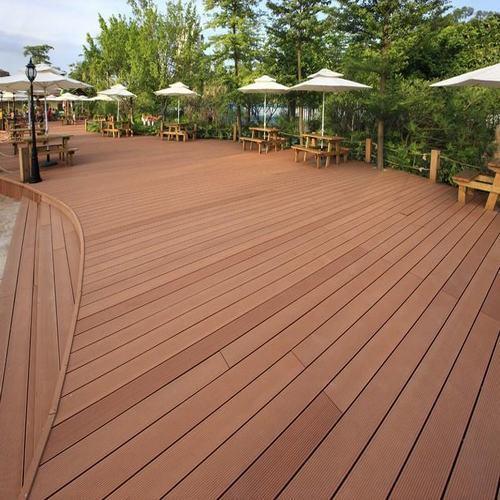Eco-Friendly Living How WPC Flooring Supports a Sustainable Lifestyle

In today’s world, sustainability is no longer just a buzzword—it’s a lifestyle choice. Homeowners, architects, and interior designers are increasingly looking for ways to reduce environmental impact while maintaining elegance and durability in their spaces. One of the most effective ways to combine style with sustainability is through WPC flooring, or Wood Plastic Composite flooring. This innovative flooring option not only enhances the aesthetic appeal of homes and offices but also supports an eco-friendly lifestyle, making it a preferred choice for modern living.
What is WPC Flooring?
WPC flooring is a composite material made from a blend of natural wood fibers and recycled plastic. This combination creates a durable, waterproof, and low-maintenance flooring solution that resembles traditional hardwood but offers superior resilience. Unlike conventional flooring materials, WPC is designed to minimize the use of natural wood, thus reducing deforestation and conserving natural resources. Its core components are primarily sourced from recycled materials, making it a sustainable alternative to solid wood or vinyl floors.
The Environmental Benefits of WPC Flooring
One of the main reasons WPC flooring is gaining popularity is its environmental friendliness. Here’s how WPC flooring contributes to a greener planet:
- Reduced Deforestation: By using recycled wood fibers instead of cutting down trees, WPC flooring significantly decreases pressure on forests. This helps in preserving biodiversity and maintaining ecological balance.
- Recycling Plastic Waste: WPC flooring incorporates recycled plastics, diverting waste from landfills and oceans. This approach reduces pollution and contributes to a circular economy where materials are reused instead of discarded.
- Low Carbon Footprint: The manufacturing process of WPC flooring consumes less energy compared to traditional hardwood flooring. By choosing WPC, homeowners are indirectly reducing carbon emissions associated with production and transportation.
- Longevity and Durability: WPC flooring lasts longer than many conventional flooring types, which means less frequent replacement. Longer lifespan translates to reduced material consumption over time.
WPC Flooring and Indoor Air Quality
Sustainability isn’t only about resource conservation; it also involves creating healthier indoor environments. Many conventional flooring options emit volatile organic compounds (VOCs), which can affect indoor air quality. WPC flooring is engineered to be low in VOC emissions, ensuring cleaner air in homes and offices. This makes it a safer choice for families, especially those with children or individuals with allergies.
Stylish, Durable, and Waterproof
Apart from environmental benefits, WPC flooring is highly versatile. It comes in a wide range of colors, textures, and designs, often mimicking the natural beauty of hardwood. Its waterproof properties make it suitable for kitchens, bathrooms, and even outdoor areas. The durability of WPC flooring ensures it can withstand heavy foot traffic without warping, cracking, or fading. This combination of style, resilience, and sustainability makes it an ideal choice for modern homeowners who refuse to compromise on any aspect.
Cost-Effective and Low Maintenance
While eco-friendly products are sometimes associated with higher costs, WPC flooring offers excellent value for money. Its durability reduces maintenance and replacement costs over time, and cleaning WPC floors is simple, requiring only a mop and mild detergent. The combination of affordability and sustainability makes WPC flooring accessible to a wide range of homeowners who wish to live greener lives.
WPC Flooring in Sustainable Interior Design
Architects and interior designers are increasingly integrating WPC flooring into sustainable design projects. It pairs well with other eco-friendly materials such as bamboo furniture, recycled metal accents, and energy-efficient lighting. WPC flooring not only adds a modern aesthetic but also aligns with LEED-certified building practices and other green building standards. Using WPC flooring is a tangible way to showcase environmental responsibility while elevating the look and feel of interiors.
Making the Switch to an Eco-Friendly Lifestyle
Switching to WPC flooring is a step toward eco-conscious living. By selecting materials that conserve natural resources, reduce waste, and improve indoor air quality, homeowners actively contribute to a healthier planet. Combined with energy-efficient appliances, sustainable furniture, and conscious consumption habits, WPC flooring becomes an integral part of a green home ecosystem.
Conclusion
Eco-friendly living is no longer a distant aspiration; it’s a practical lifestyle choice that begins with conscious decisions, such as choosing WPC flooring Abu Dhabi. With its sustainable materials, durability, and low environmental impact, WPC flooring supports modern homeowners in reducing their ecological footprint without compromising on design or comfort. From preserving forests and recycling plastics to improving indoor air quality, WPC flooring exemplifies how sustainable choices can seamlessly blend with style. Embracing WPC flooring is not just a design decision—it’s a commitment to a greener, healthier future.